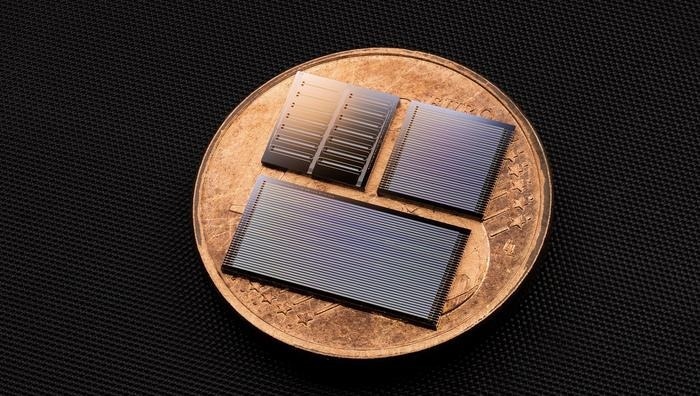Reviewed by Lexie CornerMay 9 2024
In a study published in Nature, researchers from the Swiss Federal Institute of Technology Lausanne developed Photonic Integrated Circuits (PICs), which combine several optical devices and functionality into one. This has completely transformed optical communications and computing systems.
 Lithium tantalate photonic integrated circuits. Image Credit: Tobias Kippenberg (EPFL)
Lithium tantalate photonic integrated circuits. Image Credit: Tobias Kippenberg (EPFL)
Even though silicon-based PICs have limits in their electro-optical modulation bandwidth, they have dominated the market for decades since they are affordable and can be integrated with current semiconductor fabrication technology.
Despite this, silicon-on-insulator optical transceiver chips were effectively brought to market, allowing data to flow over millions of glass fibers in modern data centers.
Recently, the lithium niobate-on-insulator wafer platform has become a top-tier material for photonic integrated electro-optical modulators. Its robust Pockels coefficient is crucial for high-speed optical modulation. However, despite its efficacy, the high costs and intricate production demands have hindered lithium niobate from achieving broader adoption, constraining its commercial integration.
Lithium tantalate (LiTaO3), a close relative of lithium niobate, should remove these obstacles. Although it has good electro-optic properties similar to lithium niobate, it is more cost-effective and scalable because telecom sectors already use it extensively in 5G RF filters.
Researchers from the Shanghai Institute of Microsystem and Information Technology (SIMIT) and EPFL, led by Professors Tobias J. Kippenberg and Xin Ou, have now developed a novel PIC platform based on lithium tantalate. By enhancing the economic viability of high-quality PICs, the PIC can revolutionize the area by utilizing the inherent benefits of the material.
The scientists created a wafer-bonding technique for lithium tantalate compatible with silicon-on-insulator production lines. They then etched optical waveguides, modulators, and ultra-high quality factor microresonators after masking the thin-film lithium tantalate wafer with carbon that resembled a diamond.
Deep ultraviolet (DUV) photolithography and dry etching methods, which were created for lithium niobate and then carefully modified to etch the harder and more inert lithium tantalate, were combined to produce the etching. Achieving high performance in photonic circuits requires minimizing optical losses, which can be achieved by optimizing the etch settings in this adaption.
Using this method, the group was able to create very efficient lithium tantalate PICs with an optical loss rate of only 5.6 dB/m at telecom wavelengths. Another noteworthy innovation is the electro-optic Mach-Zehnder Modulator (MZM), a common component of modern high-speed optical fiber communication.
The lithium tantalate MZM provides an electro-optical bandwidth of up to 40 GHz and a half-wave voltage-length product of 1.9 V cm.
While maintaining highly efficient electro-optical performance, we also generated soliton microcomb on this platform. These soliton microcombs feature a large number of coherent frequencies and, when combined with electro-optic modulation capabilities, are particularly suitable for applications such as parallel coherent LiDAR and photonic computing.
Chengli Wang, Study First Author, Institute of Physics, Swiss Federal Institute of Technology Lausanne
Due to its decreased birefringence and the refractive index's reliance on light polarization and propagation direction, the lithium tantalate PIC offers wide operational capabilities across all telecommunication bands and permits dense circuit topologies. The work opens the door to the production of sophisticated electro-optical PICs at a reasonable cost and scale.
Journal Reference:
Wang, C., et al. (2024) Lithium tantalate photonic integrated circuits for volume manufacturing. Nature. doi.org/10.1038/s41586-024-07369-1
Source: https://www.epfl.ch/